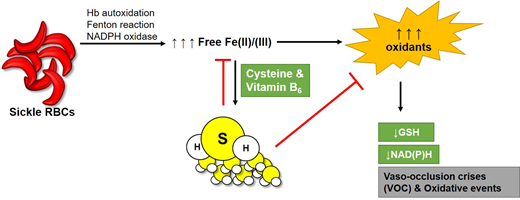In sickle cell disease (SCD), red blood cell (RBC) oxidation-reduction (redox) status is a critical determinant of hemolysis and RBC adhesion/vaso-occlusive crises (VOC). Iron, while essential for hemoglobin and RBC production, also is an important catalyst in processes that produce reactive oxygen species (ROS) which damage RBCs and ultimately other tissues. This has necessitated mechanisms for iron sequestration to control its activity, primarily achieved through binding of iron to heme, hemoglobin, and ferritin. In hemolytic disorders such as SCD, however, there is overload of protein-free, unbound iron, which by increasing ROS, significantly contributes to disease pathology. There is hence a need for novel druggable targets and treatments to attenuate this pathway of ROS production and pathophysiology. Previously, we determined a novel catalytic role of iron in which hydrogen sulfide (H2S) gas is produced both in vitro and in blood ex vivo by iron- and Vitamin B6- mediated catalysis of cysteine. We additionally determined that the bound versus unbound status of iron as well as the integrity of RBCs dictates this non-enzymatic capacity for H2S production. H2S serves as a potent regulatory redox factor throughout the body, and here we hypothesize that excess H2S in blood produced via iron catalysis protects against oxidative stress generated during SCD-related hemolytic crisis and VOC. In the current study, we further show that H2S produced in vitro from iron and Vitamin B6 catalysis of cysteine not only exists as a gas in the headspace, but itself reacts with iron in the solution. This was determined by the formation of acid labile iron sulfide, which formed a light yellow precipitate. The addition of a strong acid removed the yellow colored precipitate and resulted in further release of H2S in to the headspace. This indicates that H2S was interacting with free iron (Fe3+) and formed the iron sulfide product, which may have decreased capabilities for the formation of tissue- and cellular-damaging ROS. On-going work will examine the inhibition of H2S on iron-induced ROS generation in vitro and test the therapeutic potential of applying D-/L-cysteine and/or Vitamin B6- supplemented dietary interventions to enhance iron/B6 catalyzed H2S production in blood to lessen oxidative stress and VOC events in SCD mice in vivo. Free-iron in SCD is conventionally considered only to be a liability. However, here we exploit iron as a catalyst for beneficial H2S production in blood that can protect against oxidative stress and SCD-related pathologies. This recently discovered pathway has the potential to create novel opportunities and approaches to modulate the devastating pathophysiology of SCD.
Saunthararajah:Novo Nordisk: Consultancy; EpiDestiny: Consultancy, Equity Ownership, Patents & Royalties.
Author notes
Asterisk with author names denotes non-ASH members.


This feature is available to Subscribers Only
Sign In or Create an Account Close Modal